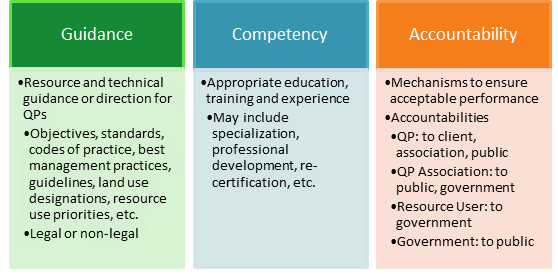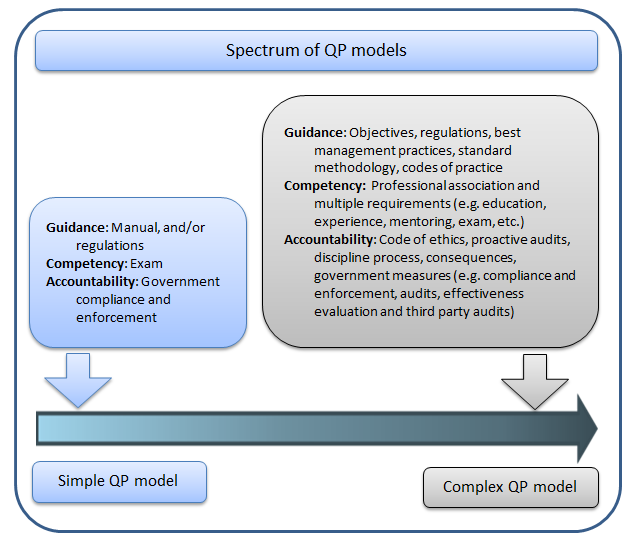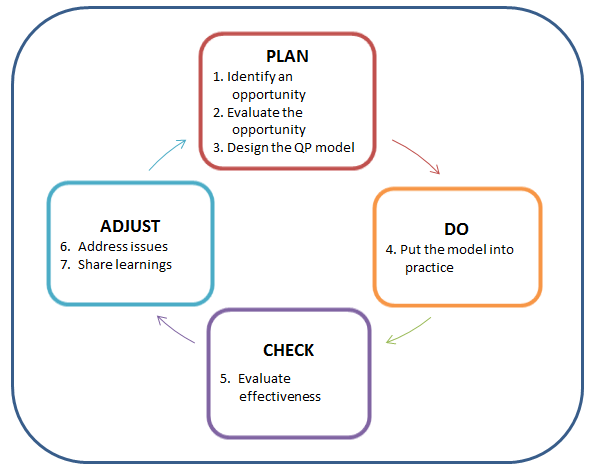Framework
In order to play an effective role in an administrative or regulatory framework, the work of a qualified person (QP) must be supported by a framework that ensures the interests of government, resource users, qualified persons and other stakeholders are recognized and addressed.
Working with industry associations, professional associations, QP service provider organizations and non-government organizations, the Qualified Persons Cross-ministry Working Group (QP working group) identified some important elements of QP use that are common across the sector. These common elements form a high-level conceptual framework to guide the use of qualified persons across the natural resource sector.
The two main parts of the framework are the essential components and the QP model development and improvement cycle.
- Essential components
There are three essential components that support a robust and effective QP model: Competency, Accountability and Guidance. If each of these components are supported to the extent necessary for the particular QP use then the “checks and balances” are in place that allow government, QP clients and the public to have confidence in the work of the QP.

Figure 1. Essential components of an effective qualified person (QP) model
Each of these three components may be supported in a number of different ways, depending on the nature of the work being performed and the context. Each combination of ways in which these components are supported forms a qualified persons model (QP model). There are many QP models currently being used in the natural resource sector. Some have been designed to address all three components to a considerable extent. Others support or incorporate the components to varying degrees, commensurate with the function and the risks involved. The variation can be viewed as a spectrum of QP models, ranging from a small and simple collection of mechanisms to support the components, to complex models with many mechanisms working together to support the competency and accountability of qualified persons and provide guidance about the outcome to achieve, or the procedures to follow.

Figure 2. Spectrum of qualified person (QP) models, from simple to complex
While no analysis has been done to confirm, it may turn out that simple models tend to be associated with lower-risk, technical work and more complex models tend to be associated with higher-risk work requiring a greater degree of professional expertise and judgement.
- Developing and improving a QP model
When developing or improving a specific use of qualified persons, the “Plan, Do, Check, Adjust” cycle should be used to consider how to support the essential components, clarify roles and responsibilities and continuously improve QP use over time.
Plan: Identify and evaluate opportunities for appropriate and effective use of qualified persons.
Do: Qualified persons carry out their functions.
Check: Evaluate the effectiveness of using qualified persons.
Adjust: Make improvements where needed.
The steps in each stage are shown in Figure 3.

Figure 3. QP model development and improvement cycle
The framework as a guide
This framework can be used as a reference when establishing a new use of qualified persons (QP). While there are many elements and considerations when establishing a QP use, an initial focus on what mechanisms or structures are needed to support competency, accountability and guidance for the function under consideration will help ensure that other elements have a strong foundation.
The framework can also be a useful reference when evaluating or considering improvements of an existing use of qualified persons.
